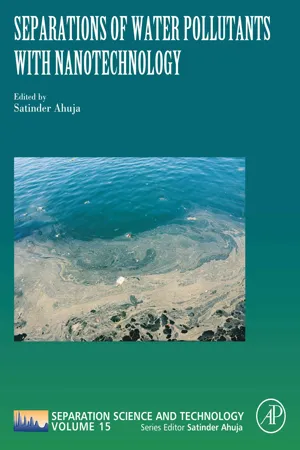
- 318 pages
- English
- ePUB (mobile friendly)
- Available on iOS & Android
Separations of Water Pollutants with Nanotechnology
About This Book
Separations of Water Pollutants with Nanotechnology, the latest volume in the Separation Science and Technology series, offers new solutions for remediating water pollution utilizing nanomaterials with separation methods. Current water purification methods are unsuitable, inconvenient or expensive, so there is a need for new and better processes and techniques. Nanomaterials can purify water by removing pollutants such as heavy metals, pathogens, organic compounds, inorganic compounds, pharmaceuticals, and chemicals of emerging concern. These can effectively replace membrane-based methods if the right expertise is developed—this book helps separation scientists do just that. Existing water treatment problems can be solved by applying a nanotechnology-based processes: antimicrobial nanotechnology, zero-valent iron nanoparticles, nanoadsorbents, nano-enhanced membranes, nanometal oxides, and nano photocatalysts. The current literature places emphasis on materials chemistry rather than the separation methods used for water purification. This new volume presents a collection of chapters that deal with remediation based on separation chemistry.
- Written by leaders in their respective fields from around the world and edited by Satinder Ahuja, a leading expert on water quality improvement
- Covers the environmental impact of anthropogenic nanoparticles and plant derived bionanomaterials, which are not contained in other books related to nanomaterials for water purification
- Illustrates key information visually wherever possible throughout the book, e.g. process diagrams in the nanomaterial synthesis and nanomembrane fabrication chapters, electron microscope images, and more
Frequently asked questions
Information
Table of contents
- Cover image
- Title page
- Table of Contents
- Copyright
- Contributors
- Preface
- Chapter 1: Overview of separations of water pollutants with nanotechnology
- Chapter 2: Importance of nanomaterials in water purification
- Chapter 3: Nanosensors for water quality monitoring
- Chapter 4: Assessing the environmental impact of anthropogenic nanoparticles
- Chapter 5: Nanocellulose in membrane technology for water purification
- Chapter 6: Plant-derived carboxycellulose: Highly efficient bionanomaterials for removal of toxic lead from contaminated water
- Chapter 7: Remediation of heavy metals with nanomaterials
- Chapter 8: Abatement of pesticides in drinking water by nanoscale carbon materials
- Chapter 9: Removing chromium (VI) from contaminated water using a nano-chitosan–coated diatomaceous earth
- Chapter 10: Recent trends of carbon nanotubes and chitosan composites for hexavalent chromium removal from aqueous samples
- Chapter 11: Applications and limitations of graphene oxide for remediating contaminants of emerging concern in wastewater
- Chapter 12: Nanoadsorption: An innovational and compelling approach toward fluoride remediation from water
- Chapter 13: Nanofiltration and environmental sustainability
- Chapter 14: Nanomaterials in polymeric membranes for water treatment applications
- Chapter 15: Applications of two-dimensional nanostructures for water filtration
- Chapter 16: New nanomaterials for wastewater depollution: Methods using chemometric approaches
- Index